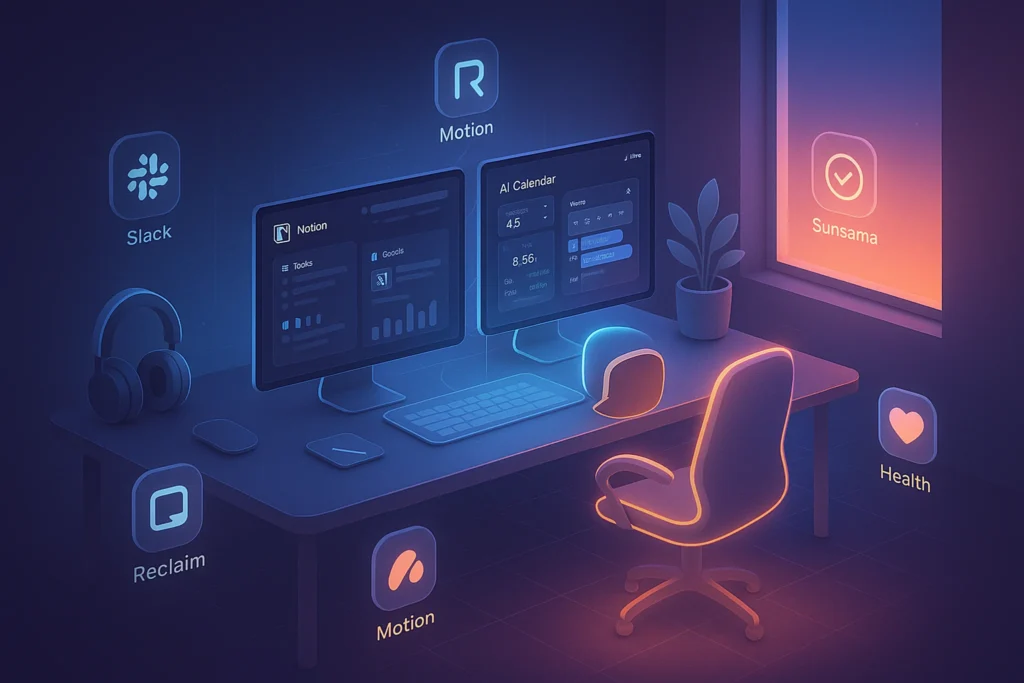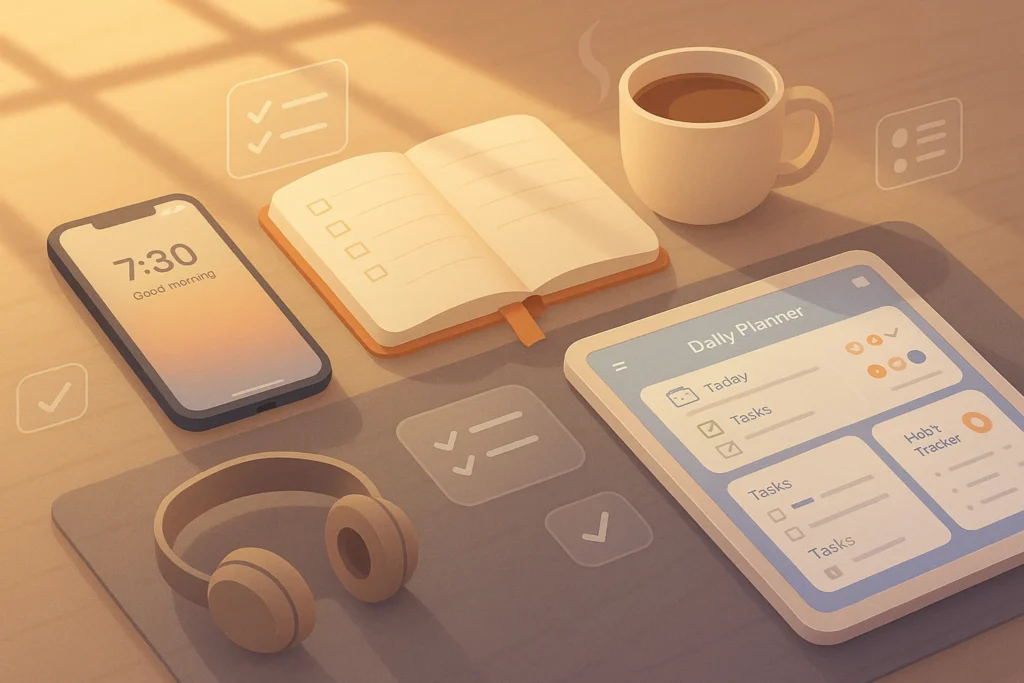-This post may contain affiliate links. If you click on one and make a purchase, I may earn a small commission at no extra cost to you.-
🚀 Intro – Why Remote Work in 2025 Is a Whole New Game
Working remotely in 2020 was about survival.
Working remotely in 2025? It’s about optimization.
What started as a reactive trend has now matured into a default mode of work for millions worldwide. But unlike the early days, today’s remote work isn’t just about having a Zoom link and Slack channel. It’s about mastering your digital environment, streamlining your workflows, and adapting your mindset to a new reality—where flexibility is expected but focus, structure, and clarity are harder to maintain than ever.
Whether you’re a full-time remote employee, a freelancer, or a hybrid professional, these 10 pro-level strategies will help you thrive in a distraction-heavy, always-on digital world.
🧠 Tip #1: Design Your Remote Work HQ
Your productivity starts with your environment. A makeshift setup might’ve worked during the early days of WFH, but to truly perform, you need a space that’s intentional.
Start with lighting—natural light improves alertness and mood, but a good ring light or diffused LED panel can work wonders too. Then, focus on ergonomics: a supportive chair, external monitor, and laptop stand reduce strain over long hours.
Noise distractions? Try noise-canceling headphones like the Sony WH-1000XM5 or Apple AirPods Pro. For video calls, tools like Opal Camera or even a ring light with webcam diffuser can give you a clean, professional look.
💡 A clean space leads to a clearer mind. Remote professionals who curate their environment tend to experience less fatigue and higher sustained focus throughout the day.
🚀 Want to Automate Your Remote Schedule?
Explore AI-powered tools like Motion, Reclaim, and Sunsama to auto-schedule deep work, block distractions, and optimize your async workflows.
👉 Read our deep dive on Best Smart Calendar Apps for Remote Teams.
🤝 Tip #2: Asynchronous First, Synchronous When It Matters
The most efficient remote teams in 2025 don’t default to meetings—they default to asynchronous communication.
Tools like Loom (for short video updates), Notion (for shared knowledge), and Slack (for async chats) reduce meeting fatigue and allow deeper work. Live meetings (via Zoom, Meet, or Teams) should be reserved for high-context, emotionally sensitive, or fast-decision topics.
The rule of thumb?
Write it first, meet if needed.
This async-first mindset not only respects time zones and energy levels but also helps reduce misunderstandings—because everything is documented.
📎 If you’re still chasing Slack threads and stuck in back-to-back Zooms, it’s time to shift how you communicate. Check out our post on Remote Work Essentials to learn how the best teams are doing it.
🗓 Tip #3: Calendar Layering & Time Zone Optimization
If you’re working with a distributed team, syncing up schedules can feel like solving a puzzle blindfolded.
That’s where smart tools like Reclaim.ai, Calendly, and Clockwise come in. These tools allow you to:
-
Auto-block focus time based on your task list
-
Show teammates your availability in their time zone
-
Layer multiple calendars (personal + work) to avoid conflicts
For solo workers or freelancers, Motion and Sunsama are game-changers—they build your schedule automatically based on priority, meetings, and habits.
📈 Mastering your calendar is mastering your energy. The difference between a reactive day and a high-performance day often lies in how well your time has been defended.
🧼 Tip #4: Tech Hygiene = Mental Clarity
Your digital setup can either support your focus—or sabotage it.
Tech hygiene means keeping clear boundaries between work and life even inside your devices. For instance:
-
Use separate Chrome profiles or desktops for work vs personal.
-
Turn off default notifications and use context-based alerts (like Slack’s keyword highlights or Focus Assist).
-
Use a minimalist phone launcher (like Niagara Launcher) during deep work hours to reduce app temptation.
Just like physical clutter causes mental friction, digital noise pollutes your brainspace. Clean it up, and you’ll think clearer, decide faster, and stress less.
💡 Nerd Tip: If your Slack, email, and calendar are all pinging at once, you’re not working—you’re reacting.
🧭 Tip #5: Structured Communication = Less Misunderstanding
When we don’t share physical space, clarity matters more than ever.
Remote professionals in 2025 excel by writing better, not more. That means:
-
Async updates with bullet summaries
-
Project decisions documented in Notion or Coda
-
Using threads and subject lines wisely in Slack/Email
-
Setting team-wide “reply windows” and tone guides
You can even use simple tools like Hugo or Tetra to create decision logs during virtual meetings—ensuring nothing gets lost in the void.
✨ Structured writing builds trust. When everything’s written clearly, you reduce tension, increase accountability, and let the whole team move faster.
⏰ Tip #6: Focus Windows with AI Scheduling
In the age of back-to-back meetings and screen-switching fatigue, deep work is the ultimate edge.
Enter AI-powered scheduling.
Tools like Motion and Sunsama don’t just remind you of tasks—they build your calendar around them. They automatically schedule your most important work when you’re at peak energy, buffer time around meetings, and shift low-priority tasks if things change.
This means:
-
No more guessing when to do what
-
Built-in focus blocks that are protected
-
Realistic daily plans based on your actual bandwidth
🎯 When your calendar defends your focus, you don’t need motivation. You just follow the flow.
Want to see how Motion stacks up? We compared it with other smart calendar tools in Best Smart Calendar Apps.
🔄 Tip #7: Weekly Reset + Async Retro
Working remotely doesn’t mean skipping reflection. The best teams build in intentional pauses.
Every week, take 30–45 minutes to:
-
Review wins, blockers, and improvements
-
Share async updates with your team (Loom or Notion)
-
Reflect on what drained you and what energized you
This weekly reset not only helps clean the slate for a productive week ahead, it also surfaces silent misalignments before they become problems.
Remote doesn’t mean isolated—but connection takes effort and structure.
🧠 Want to level up your weekly rituals? Combine this habit with insights from Top Productivity Hacks Backed by Science.
🧍♂️ Tip #8: Use Virtual Presence Tools to Stay Connected
One of the biggest struggles of remote work? Cultural disconnect.
Even if your team is async-first, a sense of “presence” still matters. Tools like Teamflow, Gather, or Tandem create virtual office vibes—where spontaneous chats and serendipitous collaboration can still happen.
They’re not just gimmicks. These platforms reduce Zoom fatigue by enabling more casual, ambient interaction—something remote teams often lose.
If your team feels scattered and flat, try creating shared digital spaces that mimic the real world. Emotional presence = stronger culture.
🧘 Tip #9: Digital Boundaries = Work-Life Survival
Just because your office is at home doesn’t mean work should follow you into the evening.
High performers in 2025 create hard stops in their day:
-
Use a ritual to signal end of work (e.g. short walk, meditation, closing laptop)
-
Set DND hours across Slack, phone, calendar
-
Consider “shutdown routines” using tools like Reclaim, FocusMe, or Opal
Most burnout doesn’t come from overwork—it comes from blurred lines. Define your digital boundaries, and you’ll protect your mental stamina.
🌙 Remember: When work ends, let it end.
🧠 Tip #10: Upgrade Your Soft Skills—They Matter More Remotely
In-person, your body language and tone carry a lot. Remotely? It’s all in your writing, your tone, your timing.
That’s why communication clarity, empathy, and listening are top soft skills for remote workers in 2025.
Practice writing updates that are concise yet warm. Use tools like Grammarly for tone detection. Ask clarifying questions instead of assuming. And above all—assume good intent in every interaction.
Want to build your personal brand and remote presence together? Start with our guide on Personal Branding for Creators.
📊 Bonus: Remote KPIs & Self-Evaluation Metrics
Working from home doesn’t mean working in the dark. High-performing remote professionals know how to track their impact—without micromanagement.
Here are a few practical ways to self-evaluate in a remote setup:
-
✅ Daily Task Completion: Track completion rate in tools like Notion, ClickUp, or Asana. Make it visible.
-
⏱ Time Audits: Use tools like Toggl Track or RescueTime to see where your hours really go.
-
📝 Weekly Self-Check Forms: Build a simple Typeform or Google Form to answer:
“What went well?”, “What was blocked?”, and “What needs change?”
📌 Measuring outcomes, not just time spent, is key. Whether you work solo or on a team, having a feedback loop increases growth and visibility.
📋 Bonus: Quick Comparison Table – Top Remote Work Tools
Sometimes, choosing the right tool is half the battle. Here’s a quick comparison of top apps by use case:
| Use Case | Tool A | Tool B | Tool C |
|---|---|---|---|
| Async Video Updates | Loom | Bubbles | Claap |
| Smart Scheduling | Motion | Reclaim.ai | Sunsama |
| Team Docs & Status Logs | Notion | Coda | Slite |
| Virtual Office Presence | Gather | Teamflow | Kumospace |
| Focus & Distraction Block | Opal | FocusMe | Freedom |
💡 Want a full guide? We break down pros, cons, and use cases in Remote Work Essentials.
🔁 Bonus: Daily Remote Work Rituals That Actually Work
Remote productivity isn’t just about apps—it’s also about rhythm. Try incorporating these small but powerful rituals:
-
🎧 Morning Focus Playlist – Start your day with a music cue (Lo-Fi, binaural beats, or your own anthem).
-
📓 Pre-Work Journaling – Use tools like Reflect or just Notion to dump your brain, clarify intentions, and prioritize.
-
☕ Virtual Coffee Breaks – Schedule 15-minute off-topic chats with teammates. Human connection = energy.
-
🌙 Shutdown Ritual – Close all work tabs, update tomorrow’s task list, then walk away (literally).
✨ Rituals build momentum and reduce decision fatigue. Over time, they train your brain to shift into work—or rest—mode automatically.
🤖 Bonus: AI Assistants for Remote Professionals
In 2025, remote workers aren’t just using tools—they’re co-working with AI.
Here’s how to integrate AI into your remote flow:
-
💬 ChatGPT or Claude: Summarize meeting notes, rewrite Slack updates, or brainstorm newsletter intros.
-
📄 Notion AI: Turn messy task dumps into polished project briefs or documentation.
-
📹 Loom AI: Auto-generate video titles, summaries, and action items from your screen recordings.
-
📅 Motion AI: Rebuild your entire day based on priority, automatically.
🧠 You don’t need to be a tech wizard. Just learn what your tools can do—and let them think while you focus.
Need a primer on the best options? Check our latest post: Best AI Tools for Freelancers.
🧠 Nerd Verdict
Remote work in 2025 is no longer the “wild west” of Slack pings and endless Zooms. It’s a professional mode of working that rewards those who engineer their days, tools, and communication intentionally.
The future belongs to those who don’t just work from home—but work smarter from anywhere.
❓ FAQ: Nerds Ask, We Answer
💬 Would You Bite?
What’s your #1 remote work struggle in 2025—focus, communication, or boundaries?
Drop it below and let’s swap pro tips 🧠👇



